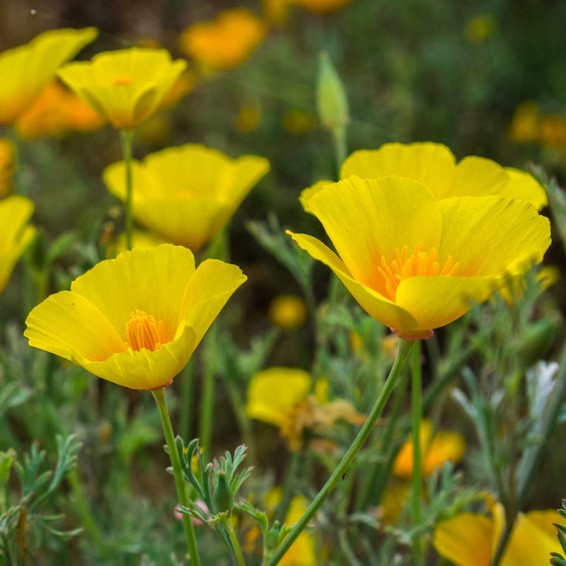Golden West California Poppy Seeds
- HOW TO GROW
- FAST FACTS
- REVIEWS
HOW TO GROW
Sowing: Sow in early spring, planting the seed 1/4" below the surface of the soil; keep the soil lightly moist until germination, which should occur in 2-3 weeks at a soil temperature of 60-65 degrees. In USDA Zones 7 and warmer, this seed can be fall planted. Poppies do not transplant well, and must be planted while very small if started indoors.
Growing: Water seedlings occasionally, but decrease watering as the plants mature; poppies tolerate drought well and will only need watering in periods of extreme dryness. This plant tolerates most soils that drain well, as well as adapting to seaside conditions. This plant does not need rich soil, and actually blooms best in poor soil. Pinch off faded blossoms for the most prolific blooming. These flowers prefer cool temperatures, usually blooming in spring and early summer and going dormant when the summer heat begins. Though an annual, it will reseed itself and return the following year. Poppies attract bees and butterflies.
Harvesting: For the longest lasting cut flowers, choose poppies that have just begun to open; cut them in the morning while the moisture is at its peak. Sear the cut ends of the flowers with boiling water or a match, and immediately plunge them into cold water. Place them in a vase with water at room temperature.
Seed Saving: When saving golden west California poppy seeds, keep in mind that the resulting flowers sometimes revert to the dominant orange or red blossoms. After the petals drop off, a capsule will form and turn from green to tan. Since the capsules will eventually split and explosively release their seeds, cut them off as soon as the color begins to turn and the seed inside has ripened to grayish black. Spread the capsules out to dry for several days, then split them to remove the seeds. Store the cleaned golden west California poppy seeds in a cool, dry place.
FAST FACTS
Latin Name: Eschscholzia californica
Species Origin: US Native Wildflower
Type: Garden Flowers
Life Cycle: Annual, Tender Perennial
USDA Zones: 1, 2, 3, 4, 5, 6, 7, 8, 9, 10, 11, 12
US Regions: California, Mountain, Arid/Desert, Plains/Texas, Midwest, Northern, Northeast, Southeast
Seeds per Ounce: 15,600
Stratification: No Stratification
Germination Ease: No Stratification
Sunlight: Full Sun
Height: 16 Inches
Color: Yellow
Bloom Season: Blooms Early Summer, Blooms Late Summer
Uses: Cut Flowers, Deer Resistant
Fabulous web site!!
Quick service. I was shocked how soon they arrived and in excellent condition. Thank you for a job well done!!
Great!
Got all the seeds I ordered nicely packaged and timely delivery!
Wildflowers
Great selection, prices and quality!! Fast fast shipping
DESCRIPTION
HOW TO GROW
Sowing: Sow in early spring, planting the seed 1/4" below the surface of the soil; keep the soil lightly moist until germination, which should occur in 2-3 weeks at a soil temperature of 60-65 degrees. In USDA Zones 7 and warmer, this seed can be fall planted. Poppies do not transplant well, and must be planted while very small if started indoors.
Growing: Water seedlings occasionally, but decrease watering as the plants mature; poppies tolerate drought well and will only need watering in periods of extreme dryness. This plant tolerates most soils that drain well, as well as adapting to seaside conditions. This plant does not need rich soil, and actually blooms best in poor soil. Pinch off faded blossoms for the most prolific blooming. These flowers prefer cool temperatures, usually blooming in spring and early summer and going dormant when the summer heat begins. Though an annual, it will reseed itself and return the following year. Poppies attract bees and butterflies.
Harvesting: For the longest lasting cut flowers, choose poppies that have just begun to open; cut them in the morning while the moisture is at its peak. Sear the cut ends of the flowers with boiling water or a match, and immediately plunge them into cold water. Place them in a vase with water at room temperature.
Seed Saving: When saving golden west California poppy seeds, keep in mind that the resulting flowers sometimes revert to the dominant orange or red blossoms. After the petals drop off, a capsule will form and turn from green to tan. Since the capsules will eventually split and explosively release their seeds, cut them off as soon as the color begins to turn and the seed inside has ripened to grayish black. Spread the capsules out to dry for several days, then split them to remove the seeds. Store the cleaned golden west California poppy seeds in a cool, dry place.
FAST FACTS
Latin Name: Eschscholzia californica
Species Origin: US Native Wildflower
Type: Garden Flowers
Life Cycle: Annual, Tender Perennial
USDA Zones: 1, 2, 3, 4, 5, 6, 7, 8, 9, 10, 11, 12
US Regions: California, Mountain, Arid/Desert, Plains/Texas, Midwest, Northern, Northeast, Southeast
Seeds per Ounce: 15,600
Stratification: No Stratification
Germination Ease: No Stratification
Sunlight: Full Sun
Height: 16 Inches
Color: Yellow
Bloom Season: Blooms Early Summer, Blooms Late Summer
Uses: Cut Flowers, Deer Resistant
Reviews
Review
Fabulous web site!!
Quick service. I was shocked how soon they arrived and in excellent condition. Thank you for a job well done!!
Review
Great!
Got all the seeds I ordered nicely packaged and timely delivery!
Review
Wildflowers
Great selection, prices and quality!! Fast fast shipping






